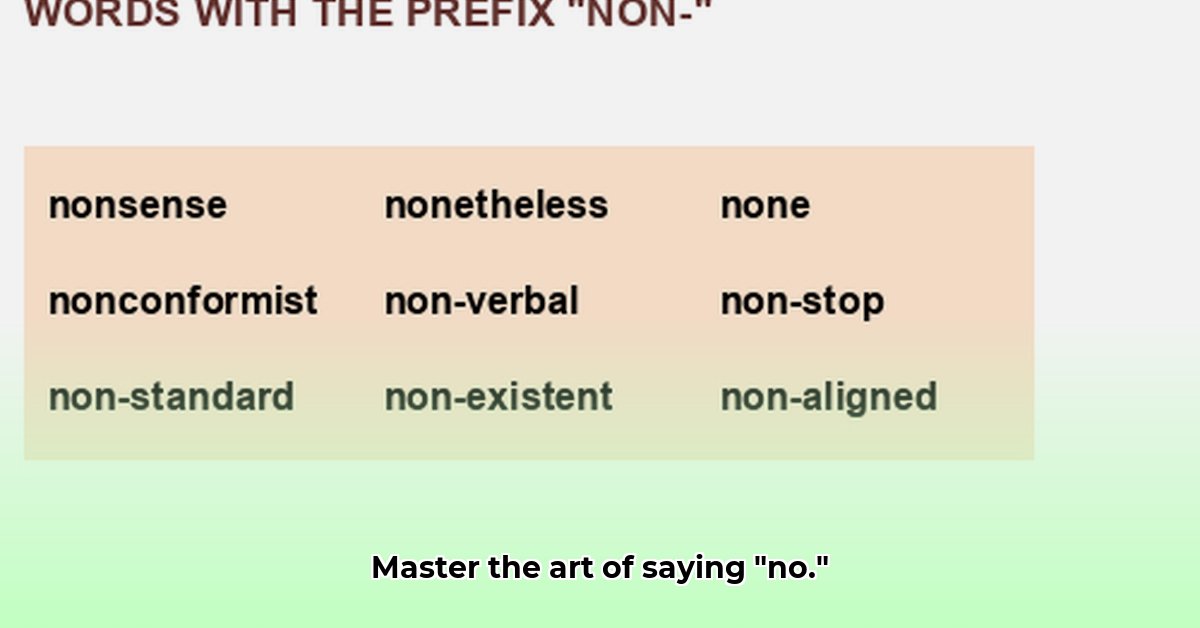The seemingly simple two-letter word “no” and its prefixal counterpart “non-” unlock a surprisingly vast and nuanced world within the English lexicon. This article explores the remarkable breadth of these words, delving into their structure, semantic complexities, and real-world applications. To understand parts of speech better, see this helpful guide on parts of speech. Prepare to be astonished by the sheer volume and diversity of words originating from this negating seed.
Decoding “No”: A Lexical Deep Dive
This exploration embarks on a comprehensive journey through the landscape of “no” words, categorizing them by length, grammatical function, and semantic field to reveal fascinating linguistic connections and shed light on their significant role in communication.
Categorizing “No”: Size, Type, and Meaning
Imagine arranging these words as one would organize a vast library. We’ll categorize them by length, part of speech (their function in a sentence), and semantic field (their area of meaning), uncovering hidden relationships and patterns within this diverse lexical family.
Word Length:
- Short and impactful (2-4 letters): Words like “no,” “not,” and “none” form the bedrock of negation. Their brevity underscores their power and frequent use as standalone negations, immediately altering the meaning of a sentence. Consider their prevalence in everyday conversation.
- Building complexity (5-7 letters): Words like “nobody,” “nothing,” and “nonsense” expand upon the basic “no,” painting a more detailed picture of absence or denial. They introduce specific entities or concepts, further enriching the expression of negation.
- Specialized and nuanced (8+ letters): Longer words like “nonconformist,” “nonnegotiable,” and “nondescript” express more complex and specialized concepts. Their length often corresponds to their specialized and less frequent usage, appearing in more formal or technical contexts.
Part of Speech:
- Nouns (representing concepts): Words like “nobody,” “nothing,” and “nonsense” represent concepts, often related to the absence, denial, or lack of something. They solidify negation into tangible entities that can be subjects, objects, or complements in sentences. Examine how these nouns shape our understanding of what isn’t.
- Verbs (expressing actions): While less directly associated with negation, verbs like “nod,” “notify,” and “nominate” can still convey negative action through context or specific usage. For instance, nodding can signify disagreement or refusal. Explore the subtle ways these verbs contribute to negative expression.
- Adjectives (describing attributes): Words like “noisy,” “nonexistent,” and “nonchalant” serve as descriptors, emphasizing the absence of a quality, the presence of its opposite, or a state unrelated to the expected norm. Consider the impact of these negative descriptors on shaping perceptions and attitudes.
- Adverbs (modifying actions or descriptions): Words like “nowhere,” “never,” and “nonetheless” act as modifiers, adding a layer of negation to verbs, adjectives, or other adverbs. They specify the circumstances, frequency, or extent of negation. How do these words modulate the intensity and scope of negative meaning?
Semantic Field:
- Negation/Absence: Words like “nothing,” “nobody,” and “nowhere” represent the core function of “no”: the denial or lack of something. They signify emptiness, void, or the non-existence of a particular entity or concept.
- Refusal/Rejection: Words like “no,” “noncompliance,” and “nonacceptance” express active opposition or denial. They indicate a conscious decision to reject or refuse something. Analyze the different shades of meaning conveyed by these words, from simple disagreement to outright defiance.
- Beyond pure negation: Words like “notable,” “nonpartisan,” and “nonprofit” demonstrate the versatility of “no” and “non-,” extending their meaning beyond pure negation. They often signify a deviation from the expected or a specific category distinct from a broader concept. How do these words challenge our preconceived notions about the function of “no” and “non-“?
Data Insights and Linguistic Quirks
The precise number of “no” words varies across different dictionaries due to varying inclusion criteria, the evolution of language, and the continuous addition of neologisms (newly coined words). Some dictionaries focus on contemporary usage, while others include archaic or highly specialized terms.
The prefix “non-” appears more frequently in longer words, possibly due to phonotactic constraints (restrictions on sound combinations in a language). The “non-” prefix may be more euphonious (pleasing to the ear) or easier to pronounce when attached to longer words.
Real-World Applications of “No” Words
The study of “no” words extends beyond theoretical linguistics, offering practical applications in diverse fields:
- Lexicography: Understanding the nuances of “no” words is crucial for lexicographers (dictionary compilers) to create accurate and comprehensive entries, reflecting current usage and etymological origins.
- Game Development: The variety and complexity of “no” words provide a rich resource for game developers, enabling them to design engaging word games and puzzles that challenge players’ vocabulary and strategic thinking.
- Natural Language Processing (NLP): Accurate interpretation of negation is essential for NLP researchers, allowing them to develop algorithms that understand the subtleties of human language, including sentiment analysis and information retrieval.
- Education: Exploring the nuances of “no” words can enrich vocabulary instruction, encouraging students to appreciate the power and diversity of negative language and its crucial role in effective communication.
Beyond the List: Further Exploration
This exploration serves as a starting point for a deeper dive into the world of “no” words. Further research could investigate regional variations in usage, trace the historical evolution of specific terms, explore the interaction of “no” with other prefixes, and analyze the psychological and social implications of negative language. The rich complexity of negation warrants continued investigation and promises further linguistic discoveries.
- Medieval Houses: A Social History Through Architecture - April 29, 2025
- Unlock Senior Perks: How Old is a Senior Citizen?Complete Guide - April 29, 2025
- Happy Patients: Tech Solutions for Better Healthcare - April 29, 2025
















